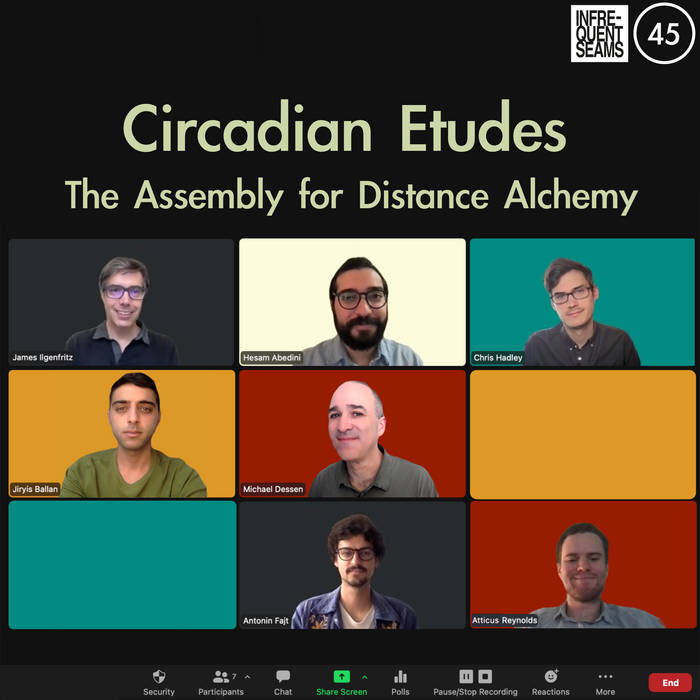The Highly Collective Work of ICIT’s “Circadian Etudes”
And the pursuit of ‘remote interconnectedness’
Inherent to UCI’s Integrated Composition, Improvisation, and Technology (ICIT) Ph.D. program is collaboration; all projects to emerge from the ICIT program suggest a degree of collectivity and interactivity. Rather—the entire music-making process, from the broad, freeform inception of ideas to the focused, deliberate conditions of practice, undergoes the combined influences of fellow students, faculty, and audience. Hardly is it the case where some part of the process occurs in isolation.
These are the conditions from which “Circadian Etudes” emerges. Released September 20, 2022, the ICIT-adjacent album represents the culmination of a spring quarter-long intensive in improvisational music-making—an extended session in heightened creativity and collaboration. The album is an interpretation of the circumstances which permitted the group’s virtual performance—an interpretation that considered the physical, perceptual, and otherwise external influences on each of the improvisers’ abilities to perform.
The album was created during an ICIT graduate seminar on improvisation, led by Professor Michael Dessen in spring 2021—when classes were still required to meet online. The six graduate students in the seminar—Hesam Abedini (vocals), Jiryis Ballan (buzuq), Tony Fajt (keys), Chris Hadley (percussion, electronics), James Ilgenfritz (bass), and Atticus Reynolds (drums, keys)— composed the music alongside Dessen (trombone), and eventually named themselves The Assembly for Distance Alchemy.
Above all is a sense of mutuality, where improvisers seem to repeatedly exchange glances by way of sound
In “Circadian Etudes,” it’s clear that the number of improvisers—and their respective experiences in improvisational composition—is directly proportional to the variances of meaning and sound recognized in the work at large. Conceptually, the album draws on the notion of shared resonances, as a sort of unique combination of meaning and sound. In a description of the album, Dessen writes that the seven improvisers “[drew] on resonances mined over months prior.” Here, the use of ‘resonance’ is itself manifold, referring to experiential, emotional, and sonic resonance in the same breath.
In its literal sense, “resonance” refers to the state in which two (or more) sound frequencies grow increasingly intense as they match one another. But in the more frequently colloquial, ICIT-sense of the word, ‘resonance’ resembles a sort of connection, a shared, discernible expression of (or gravitation toward) a particular sound. Often, this is an ‘experiential resonance’; a resonance that draws on the shared experiences of its corresponding musicians. “You can resonate with the way someone navigates those things, in the sense that you share a similar feeling of the kinds of materials you want to express,” said Dessen. “But those are often also sort of connected to your histories, of shared listening experiences.”
Dessen explains that certain tracks—“Flextangled” and “There’s a heartbeat at the end”—would not have been possible without the channeling of shared resonances in jazz traditions. These collective resonances are made manifest through the group’s distinct playing techniques. In fact, the degree of interactivity and interplay itself draws on joint jazz sensibilities.
In reference to sound, these multi-meaninged resonances may at once strike joy and terror, quiet and contemplation—or, as the Assembly for Distance Alchemy puts it: “peace, agitation, playfulness, introspection and collective exuberance.” Certain tracks sound as if repeatedly sewn together and torn apart, a sort of sound-collage where listeners are able to locate where—and when—the group intersects, overlaps, and diverges. Above all is a sense of mutuality, where improvisers seem to repeatedly exchange glances by way of sound. Where one leads in a musical gesture—and so sets the scene, or ‘soundscape,’ wherein other improvisers are invited to join—another may follow with his own understanding of how best to interact with the sounds grounded before him.

Image: The album cover for Circadian Etudes by The Assembly For Distance Alchemy
ICIT student-faculty collaborations are common, Dessen explained, and take many different forms. On “Circadian Etudes,” Dessen is a performer equal to the graduate students, and in other contexts, faculty and students might share the stage or develop research projects together. The ICIT program has (roughly) 12 Ph.D. students and five core professors, including Kojiro Umezaki, a noted shakuhachi performer and member of Yo-Yo Ma’s Silk Road ensemble; Mari Kimura, a contemporary violinist and inventor of the handheld Music/User Gesture Interface Control (MUGIC) device; Chris Dobrian, a leading researcher and composer in the field of computer music; and Rajna Swaminathan, an acclaimed composer, scholar, and mridangam player.
Inevitably, Dessen explains, challenges arise from working with students whose time and efforts are limited by the parameters of the 10-week seminar. Many courses in the ICIT curriculum must fulfill a specific purpose.
But, in this case, the situation was unique: “We just happened to have a class where all six graduate students were strong improvisers with prior experience, and so I thought, ‘what better way to actually study improvised music than to full-on do it, and create a professional album together?’” said Dessen.
“Since I was the teacher, I acted as a producer-facilitator, but the goal was to allow for as much collective work as possible. This kind of collaborative bandleader role is one of the gifts we inherit from jazz traditions, where musicians have long explored the art of sharing musical authorship in real-time.” For Dessen, there’s active engagement in the art of applying one cohesive practice or tradition to another, seemingly incompatible medium or genre of music performance. Dessen in particular does the work of mapping traditional jazz frameworks onto today’s high-tech mediums of communication and collaboration.
Over the course of composing, recording, and ultimately releasing the album, Zoom had become the unsung eighth member of the group. For better or worse, the platform mediated nearly every group social interaction. During the production of the album, there existed a sort of reciprocal relationship between the improviser’s immediate acoustic, environmental space, and the degree of participation in the resultant virtual performance.
“The conditions of recording in that sense can really impact your aesthetic choices of what to do with the material. Maybe you are more drawn to timbral exploration in a space like this than you would be otherwise, or drawn to it in a different kind of way,” said Dessen.
I'm often more interested in the relationship between things than the things themselves
“Circadian Etudes” ultimately landed on the record label Infrequent Seams, run by the ICIT fourth-year graduate student (and one-seventh of the Assembly for Distance Alchemy) James Ilgenfritz.
An exploratory, interdisciplinary performer, Ilgenfritz was drawn to UCI’s ICIT program as an improviser first and composer second: “This is one of the few places where it is its express intention that the integration of composition, improvisation and technology is central to the purpose of what’s going on here. I gradually became more of a composer over the years; about 10 years ago I started to take the notion of composing music for ensembles and for others rather than simply for my own band… so this program was really perfect because it was a place where all these identities could coexist. I didn't yet have a clear idea of what types of ways my work would intersect with technology, but that's also one of the nice things about this program: if you’ve got a clear idea of what you're doing with two of those three things, then once you're here, you’re sure to find a really meaningful way to engage with that third thing as well. And that’s certainly happened for me here.” James was also buoyed by prior connections to Mari Kimura—having been a longtime admirer of her work in subharmonics—and Michael Dessen, who he’d known for almost ten years prior to the program.
Equally important to Ilgenfritz was the fact that, in 2019, “UCI was ranked number one in the country for social mobility, setting alumni up for great success after they finish here. It’s deeply inspiring to know that I’m creating my work within this environment that is facilitating such growth and potential for greater achievements.” Ilgenfritz admitted that, when he had first heard about this, he was struck with “intense pride” in his school and subsequent program.
Interestingly, Ilgenfritz has expressed a very well-defined, precise taste in sound (or, rather, the construction of sound): “I like very simple sounds and I like very complex sounds. I just like things that cause you to pause and think; I’ve gotten the last few years into just intonation, a more rational system of tuning.” He elaborates his interest in sounds that draw upon the unusual or unfamiliar. Ilgenfritz, too, gravitates toward sounds of pause and contemplation, dissonance and discord. Simply put: sounds that evoke or provoke.
“As an improviser primarily, I’m really focused on how I can use extended techniques—just using an instrument in the way that it was not specifically designed is a fun concept. I think of it as being related to visual arts, because so many aspects of visual arts are about repurposing materials, and I think that's very much what I’m doing with my work as a bass player.
“I'm always trying to make connections across disciplines. I like to look for connections between unlike things… I'm often more interested in the relationship between things than the things themselves, which I realize is kind of a form of thinking about the ecology of sounds and ideas.” For Ilgenfritz, the more seemingly disparate the two forms, the more gratifying it becomes to see the connections between them.
Ilgenfritz participates in highly cross-disciplinary, multimedia performance spaces, often embedded with text, spoken word, and visual imagery. Moving forward, he hopes to more overtly pair alternate forms of media alongside his own live music—even ‘non-music’ objects (think everyday household objects) as instruments. For Ilgenfritz, the joy of the work is infinitely generative.
“We’re always looking for new ways for these separate disciplines to interact,” said Ilgenfritz.
We’re always looking for new ways for these separate disciplines to interact.
“Circadian Etudes” is at once an experimental and experiential amalgamation of sound, form, and movement. Transgressive, thoughtful, and wildly interpretive, the album confounds expectations of improvised, experimental music while considering what it means to perform physically separate, but musically joined. Dessen referred to the project as “kaleidoscopic”; Ilgenfritz compared it to an “origami cosmos,” where each improvised gesture, though distinct to the performer, can be mapped to “one continuous fabric” that unfolds to reveal resemblances among the improvisers.
Both Dessen and Ilgenfritz agree that the point is not to replicate the experience of in-person music performance, but to realize and celebrate the alternative, parallel experience of virtual music performance. Adapting certain musicalities to virtual presence is, after all, part of what makes the work of virtual performance so special.

